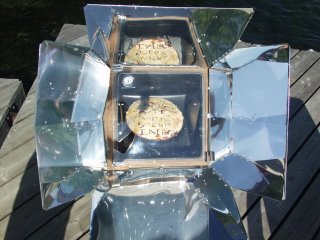Solar pie

Canada Day, July 1st, 2006. Parry Sound.
Welcome to Cooking Without Carbon, which chronicles my attempt to cook more of my food without burning up fossil fuels, or emitting carbon into the environment. "Cooking without carbon" is something most Canadians can do.
Please visit the website of my company, Sun Baked, at www.solarcooking.ca. Sun Baked is promoting the mass adoption solar cooking in Canada. Yes, Canada. Contrary to popular belief, we have enough solar energy to cook with. Don't beleive me? I'll prove it too you.
Here's a recipie for my strawberry solar pie, cooked with the sun in Parry Sound Ontario at 45.20 degrees north lattitude on Canada Day 2006 and consumed with relish by my friends and I.
Filling
I like to make the filling first.
Clean and cut enough strawberries to fill your pie dish. I like to use a scalloped, non-stick French tart pan.
TIP: The tart pan works with solar cooking because of its dark colour, and because it weighs almost nothing. Heavy, ceramic cooking dishes don't work well with solar cooking. The mass of the cooking dish sucks up all the energy from the solar oven. You want your food to be much heavier than your cooking vessel.
I also used Rhubarb with this dish, donated by my neighbour Barb from her own garden. Cut the Rhubarb into small peices, and put in a small pan with sugar to taste and a tiny bit of water. Put the pan in the solar oven, and let it cook for 1/2 hour until Rhubarb is soft.
TIP: Preheat your oven with the pan inside first. Cooking time will be shorter.
For the dough, I am sharing here for the first time my favourite recipe for the flakiest pie crust you will ever eat. I'd been making this crust in both gas and convection ovens for a decade before I "went solar" on this recipe. It works with solar ovens too.
Crust ingredients
2 1/4 cups organic all purpose flour
1/4 teaspoon ground nutmeg
1 teaspoon of salt
1 tablespoon sugar
1 orange, grated
10 tablespoons unsalted butter
5 tablespoons cold (put it in the freezer first) shortening
8-10 tablespoons fresh organg juice
How to make the flakiest pie crust.
It's not just the proportions of ingredients in baking, but also the process of making the dough that creates a magical, flakey crust. Here's my secret.
Mix the dry ingredients above in a large mixing bowl. I like a heavy, ceramic bowl for this. Lightweight stainless steel bowls I like less, but are still ok. Chill the bowl beforehand.
Cut the butter and shortening with knives. Don't know how to do this? Hold two butter knives, one in each hand. Place the tips of both knives in the centre of the bowl, and cut outward rapidly, breaking up the small peices of butter and shortening, and "cutting the butter into the flour." Do this for 5 to 7 minutes, or until the butter and shortening are the size of peas, and well blended with the flour. This "cutting in" will tire your arms, but it's the frist step to flakey short pastry.
When the butter and shortening have been cut in, give your arms a rest for 20 minutes and put your bowl back in the refrigerator. (Yes, you are using some carbon energy in your fridge. Renewable refrigeration can be had if you have a cool basement.) Cooling down the dough prevents the butter and shortening from melting into the flour as its temperature is raised while being worked. Prevent melted butter at all costs during dough making.
When the mixture is chilled, you can add the orange juice. Use no water. I add a bit of juice at a time, and blend it in with a fork until the dough starts to stick together. Then I use my hands to gently knead the doough and work the moisture through. Seperate the dough into two balls, roll in flour, wrap with two clean cloths and put back in fridge or basement to cool down. (Kneading the dough raises its temperature. You want cool dough to work.)
Roll out the dough. I like to use my hands, to press the dough flat with the ball of my hand and work it outwards in a cricle from there. Or you can use a rolling pin, which is not as warm as your hand. (I run my hands under cold water first, then dry them off and flour them before kneading. What can I say? I'm a die hard baker.)
Place the crust in the bottom of the pan, and use a small dough ball from the side to gently work the dough into the grooves of the pan.
Now add your filling, the cut up strawberries and cooked rhubarb together and spread evenly in the crust filled pan. Take an egg and beat it. Glaze the outer edge of the bottom crust with the egg mix, then place the top pie crust on top. Cut away the excess with a knife for a nice clean edge (my preference) or else bunch up the crust between your thumb and fingers for a thicker more homestlyle pie crust. Glaze with the beaten egg mixture, and cut some holes.
I chose to write something in the crust. "1oo% made with solar energy."

Now the pie is ready for the solar oven.
In Parry Sound, we had some early clouds, so I didn't get cooking until around 3:00 PM, well past solar noon.
No worries. Though the baking took more than two hours, we enjoyed a lovely solar pie, together with whipped cream. I added some lemon juice to the whipping cream. It tastes better and also whipps faster, due to the acidity of the lemmon. There were no leftovers.

1 Comments:
delicious pie??heheehe
Post a Comment
<< Home